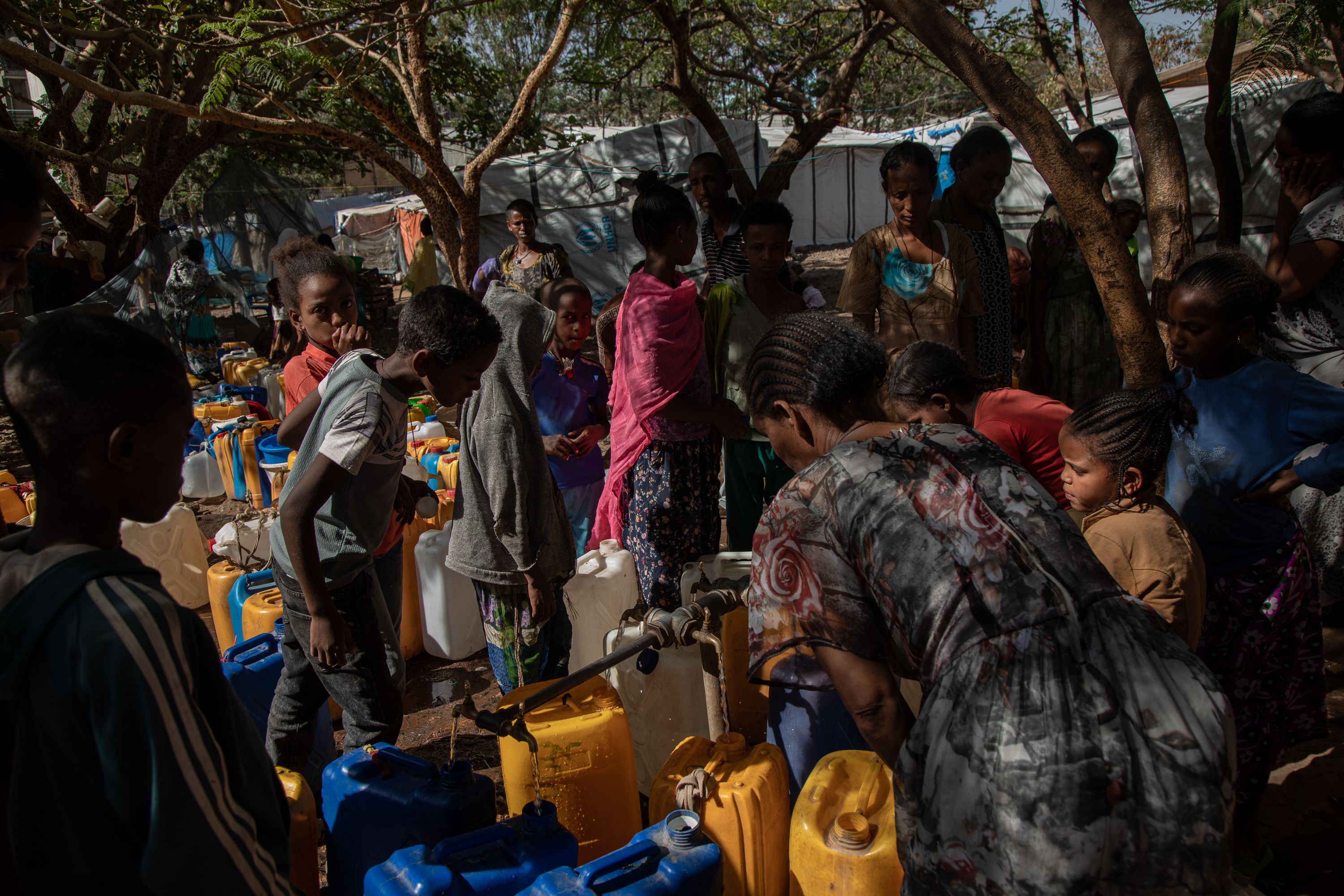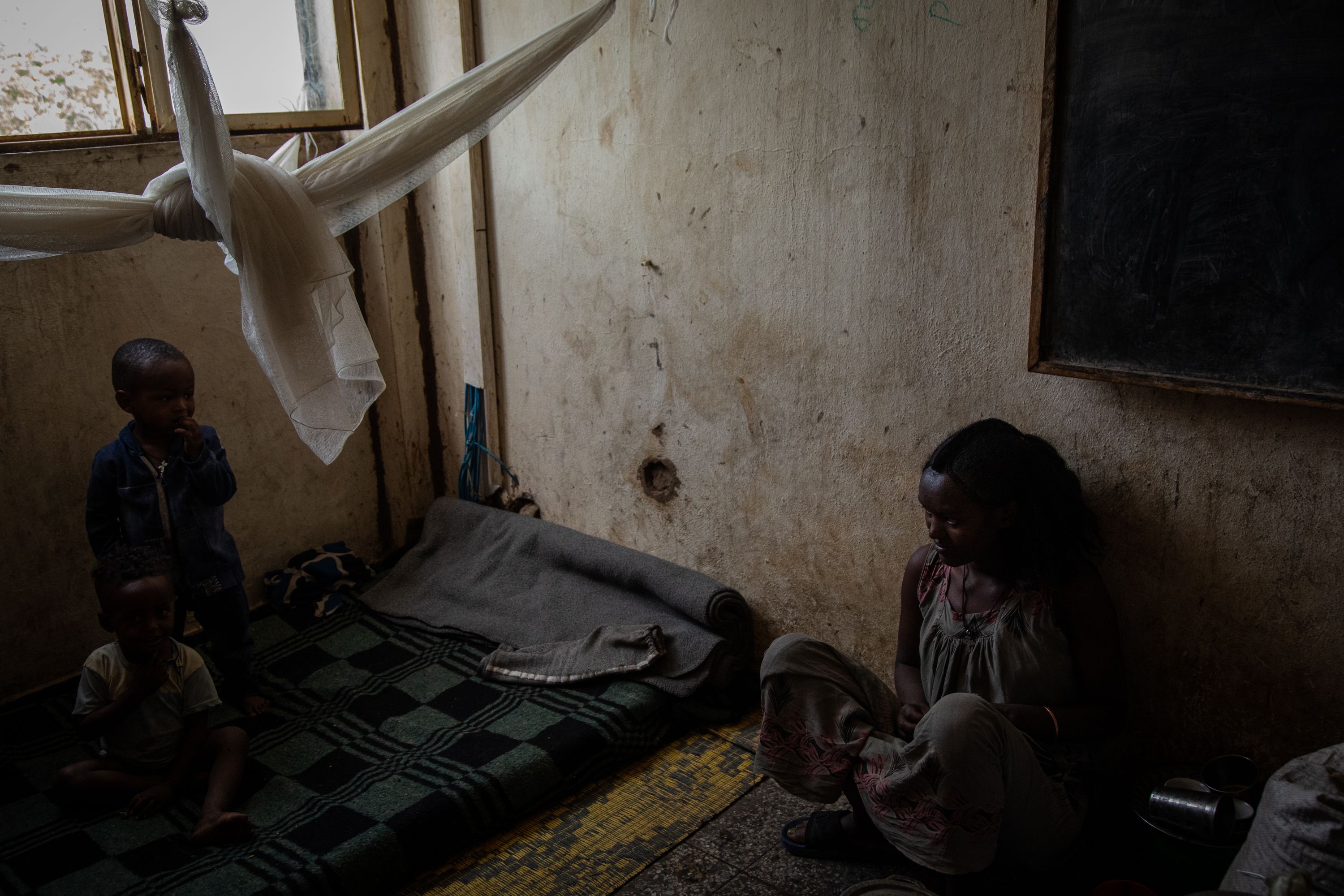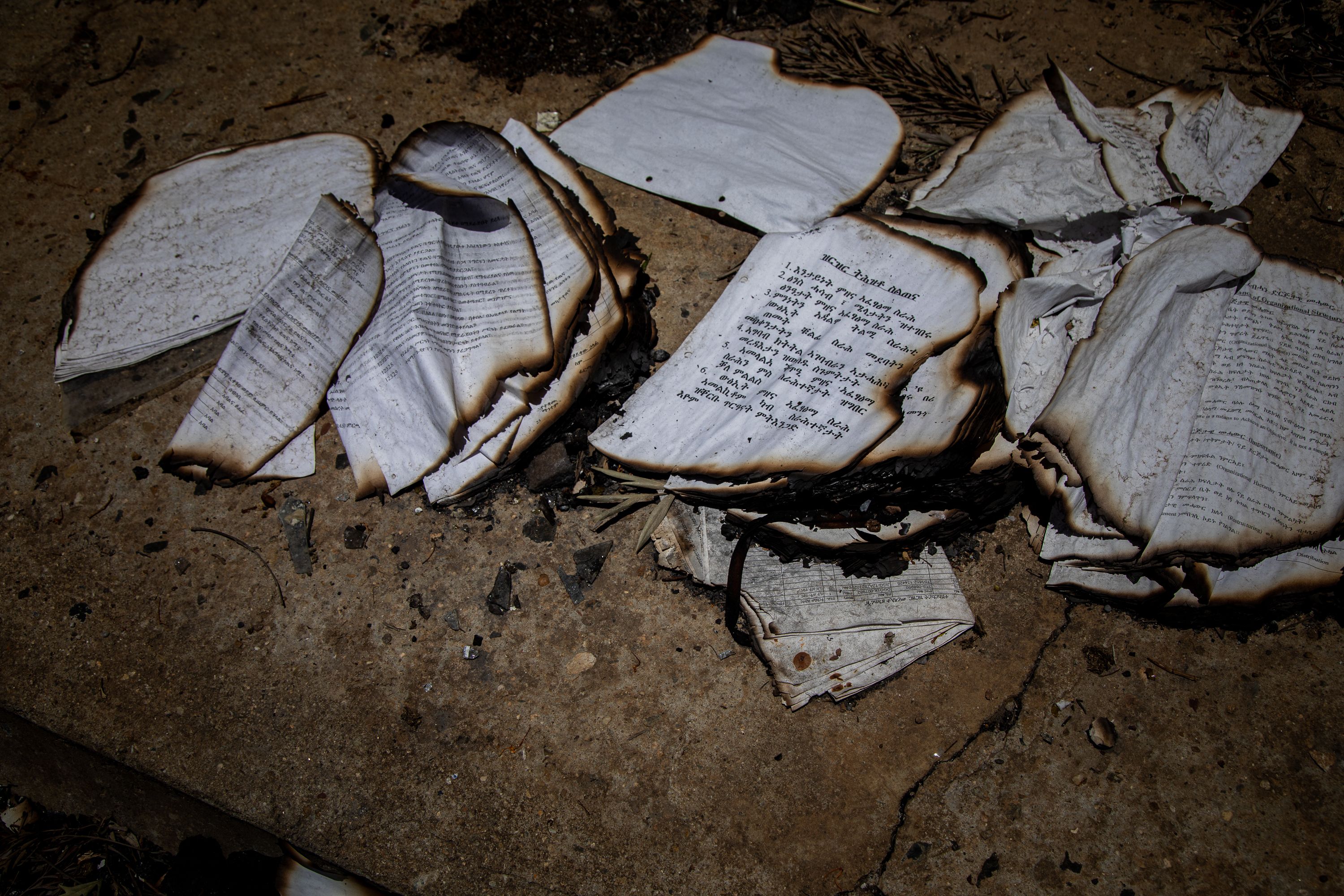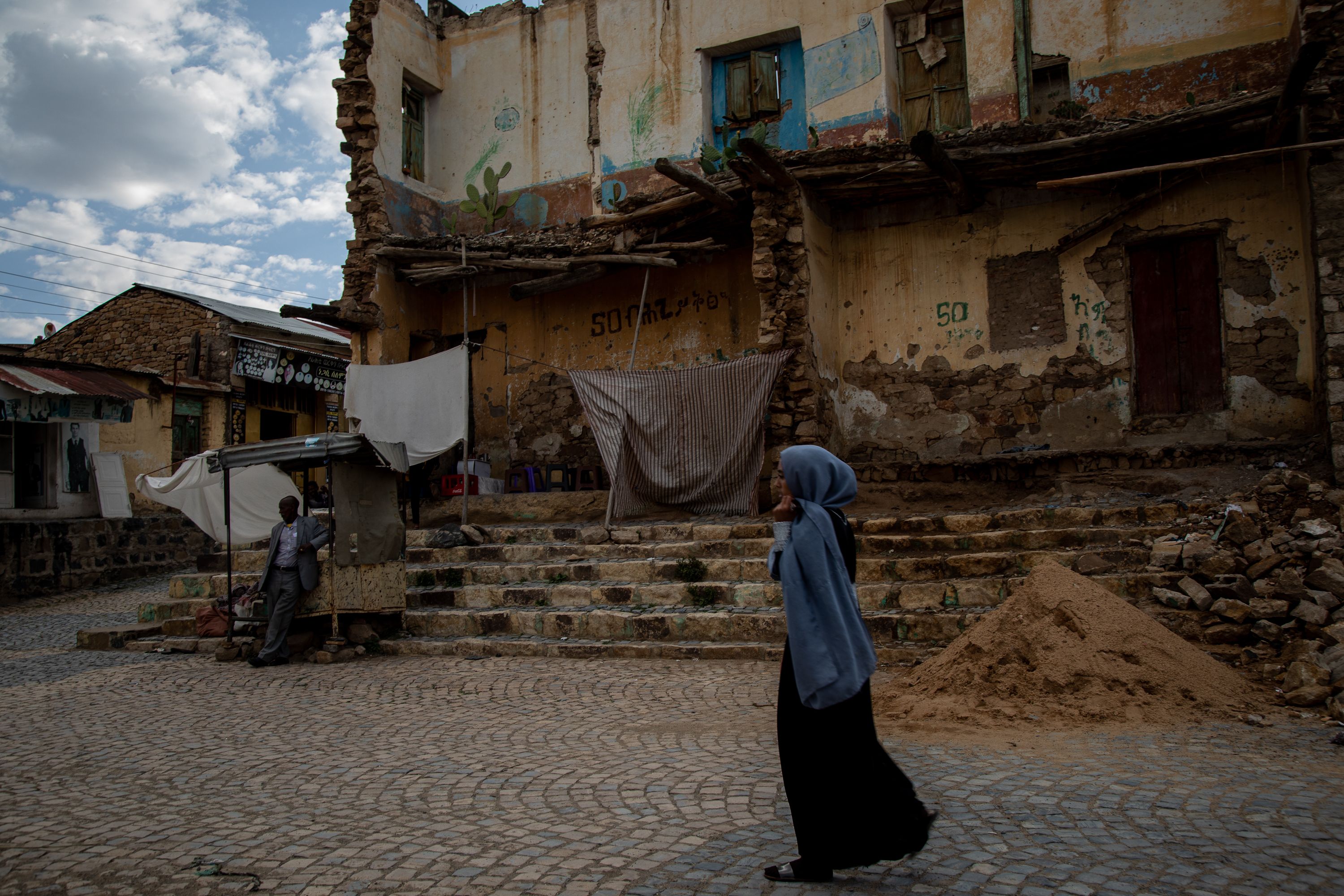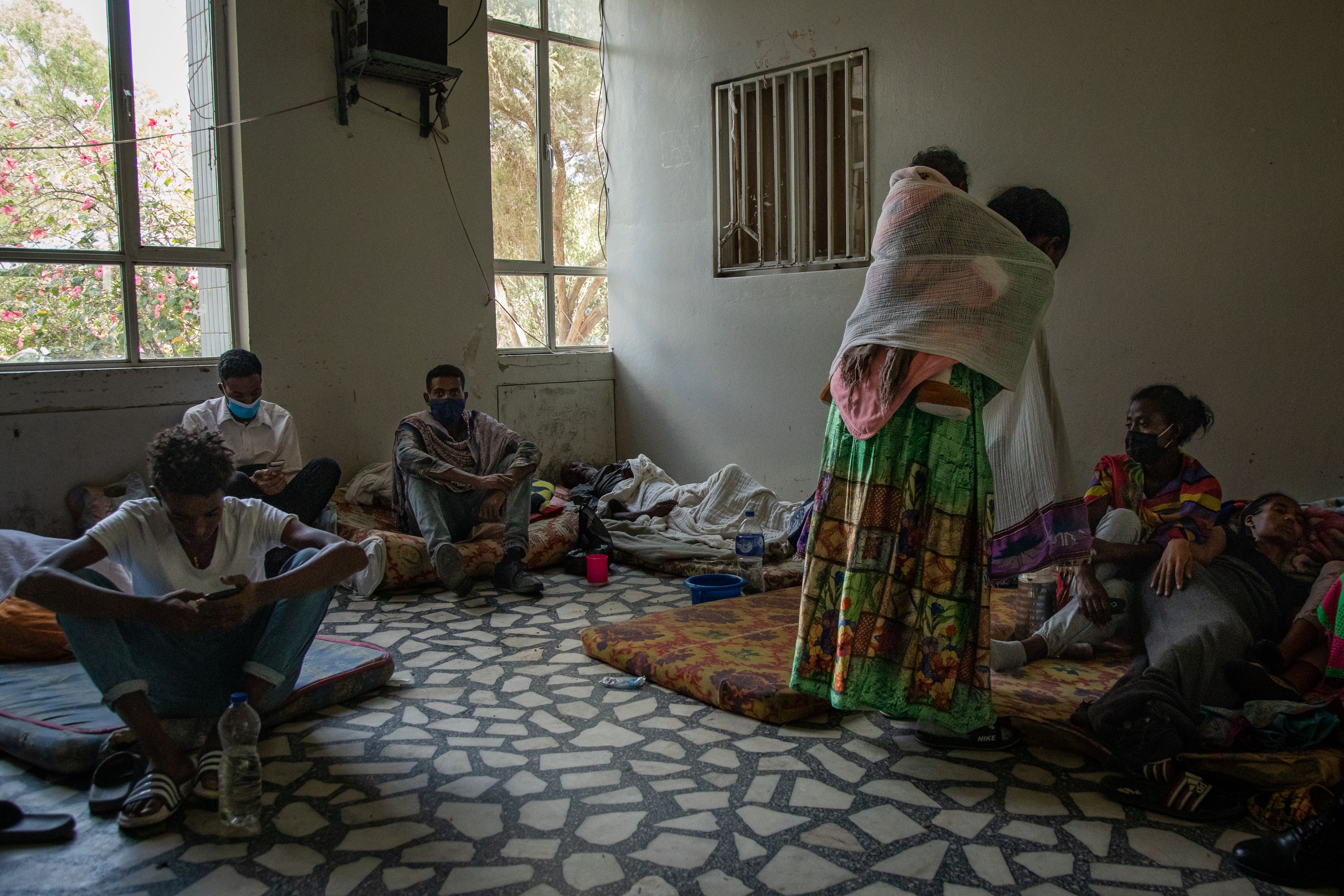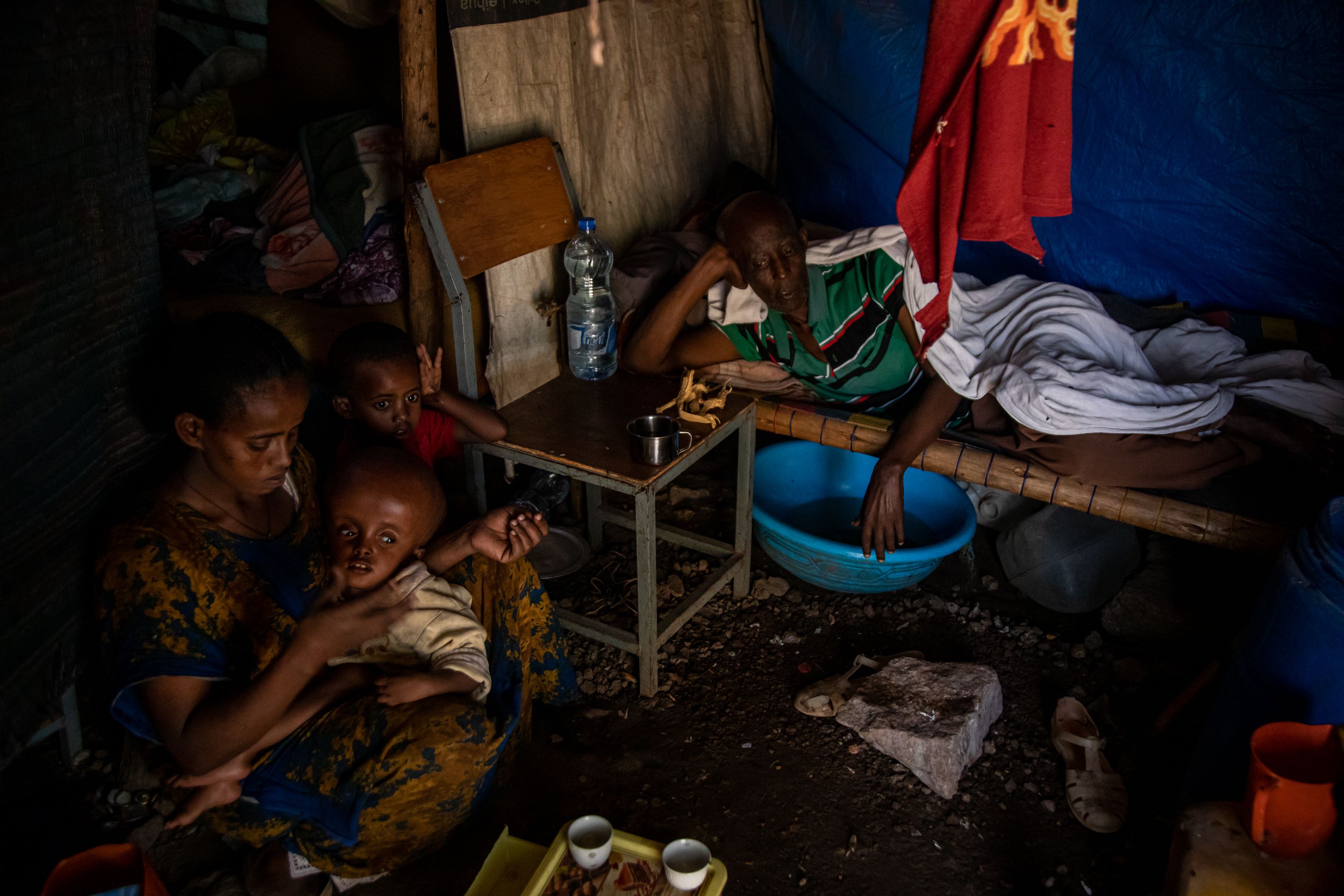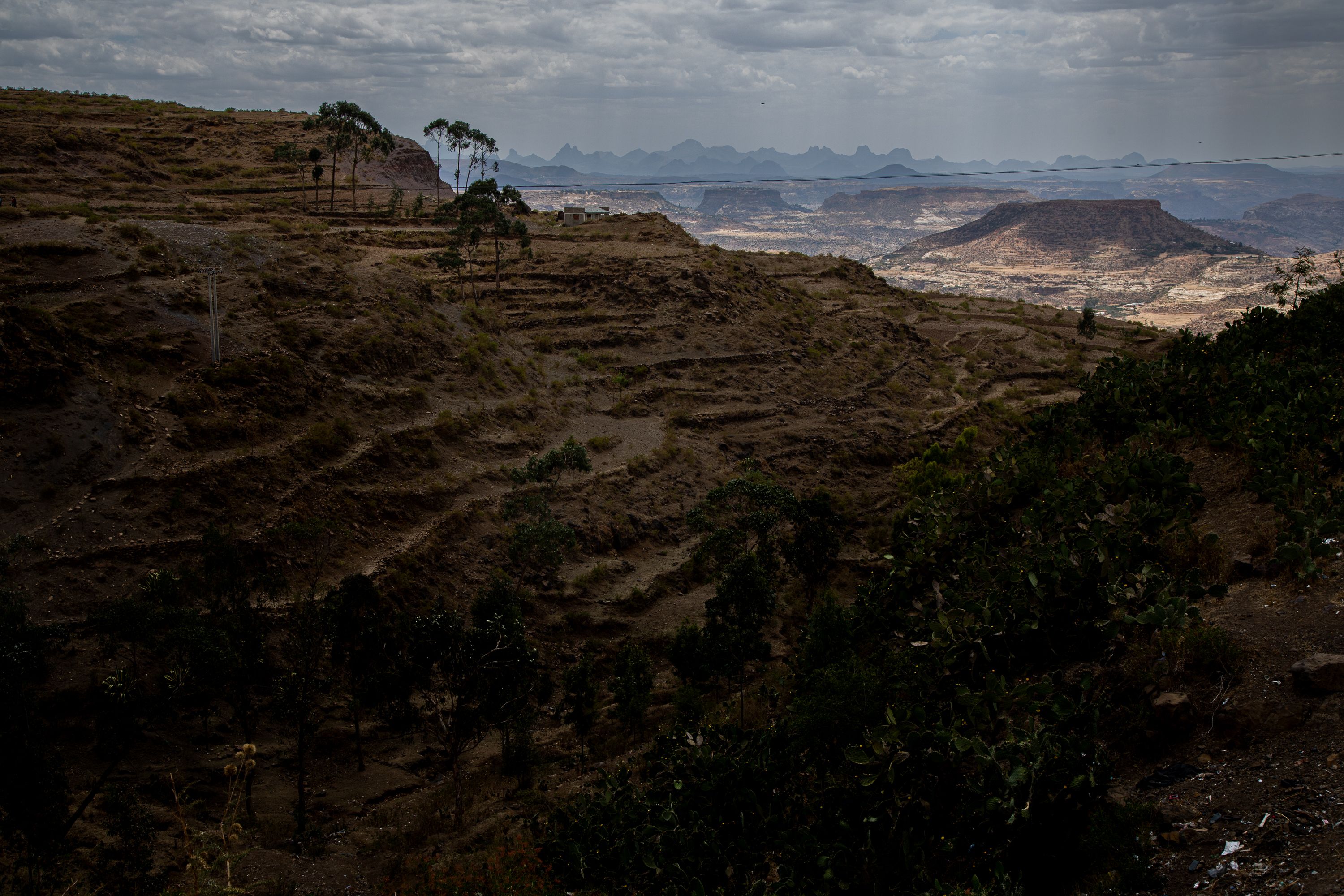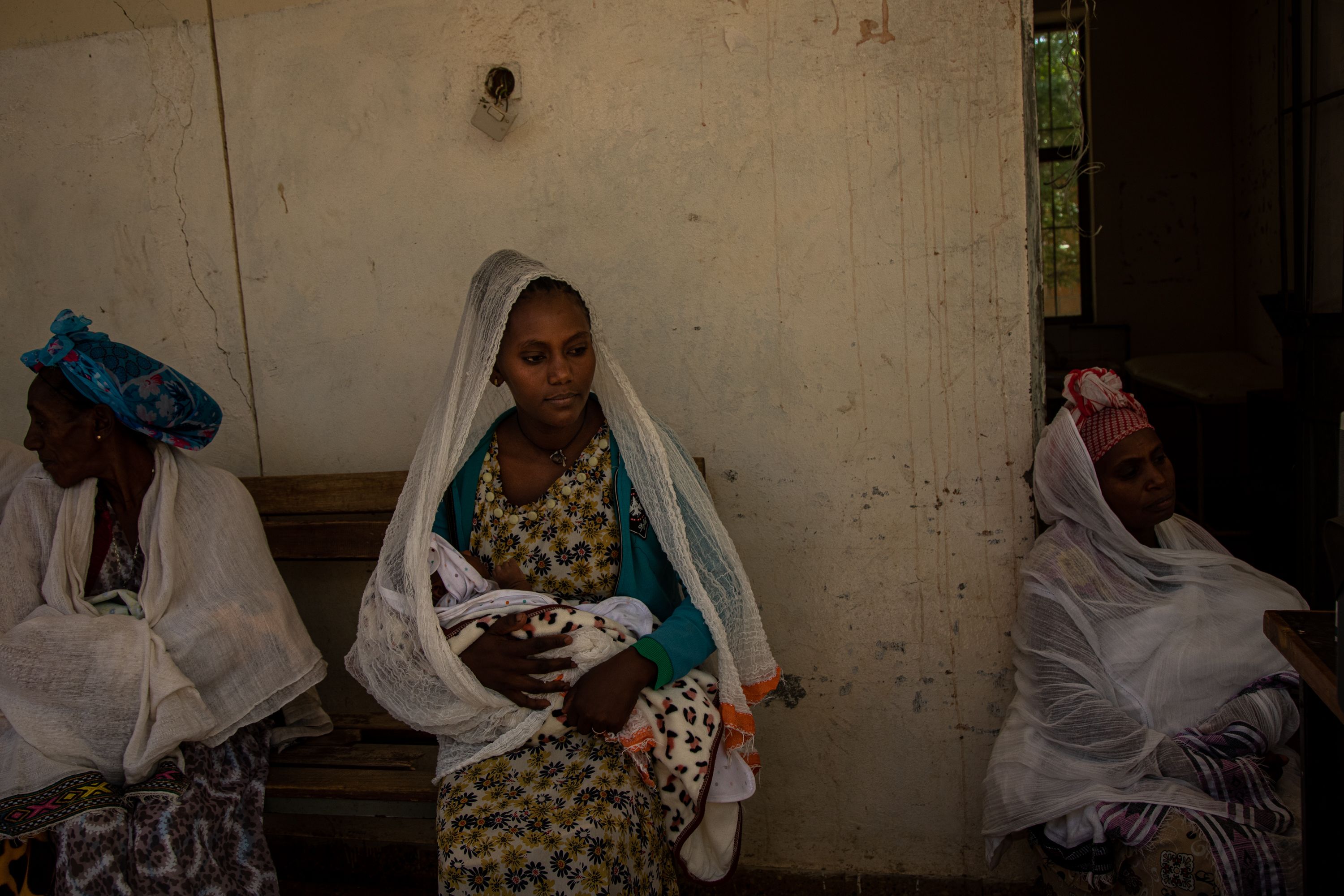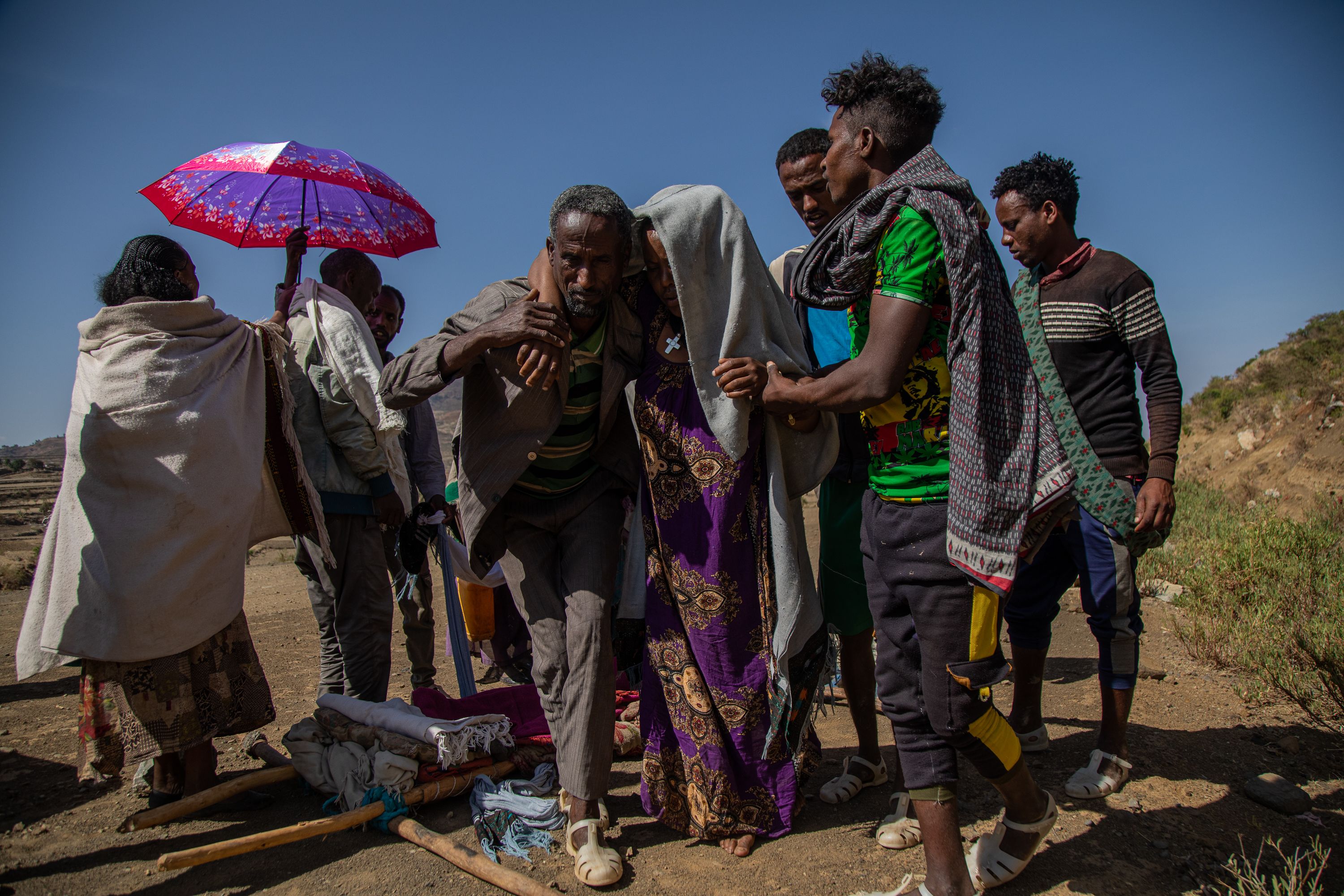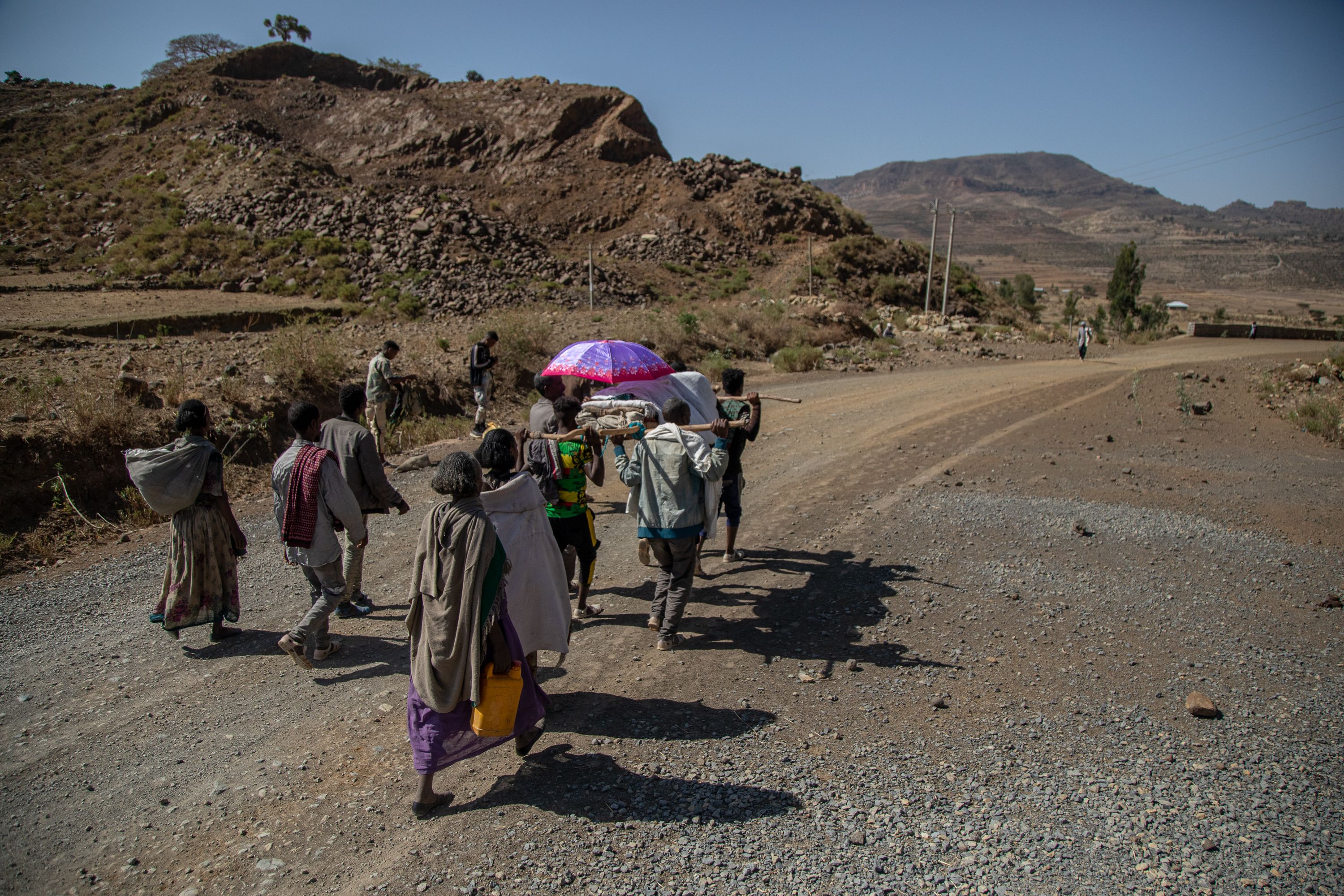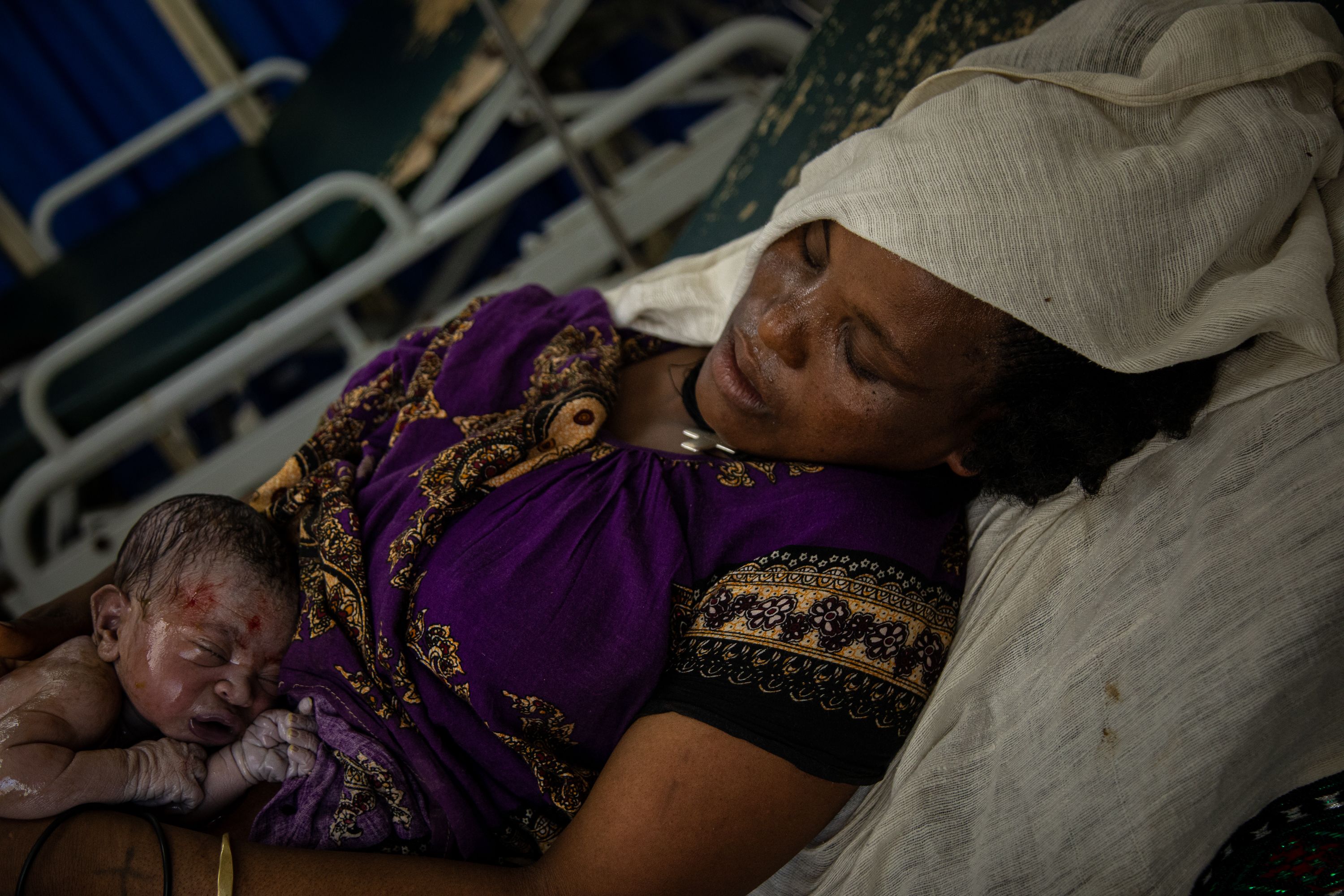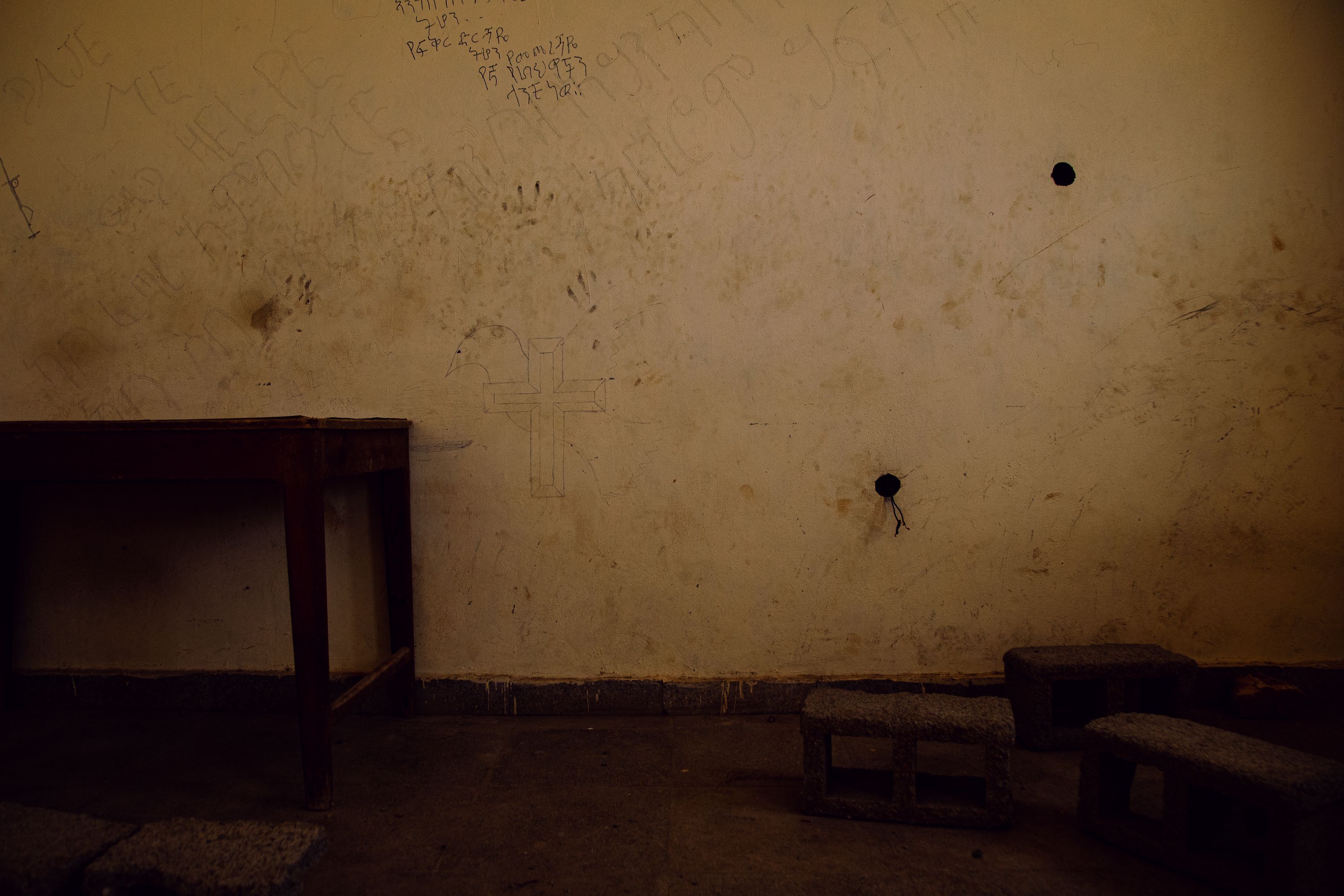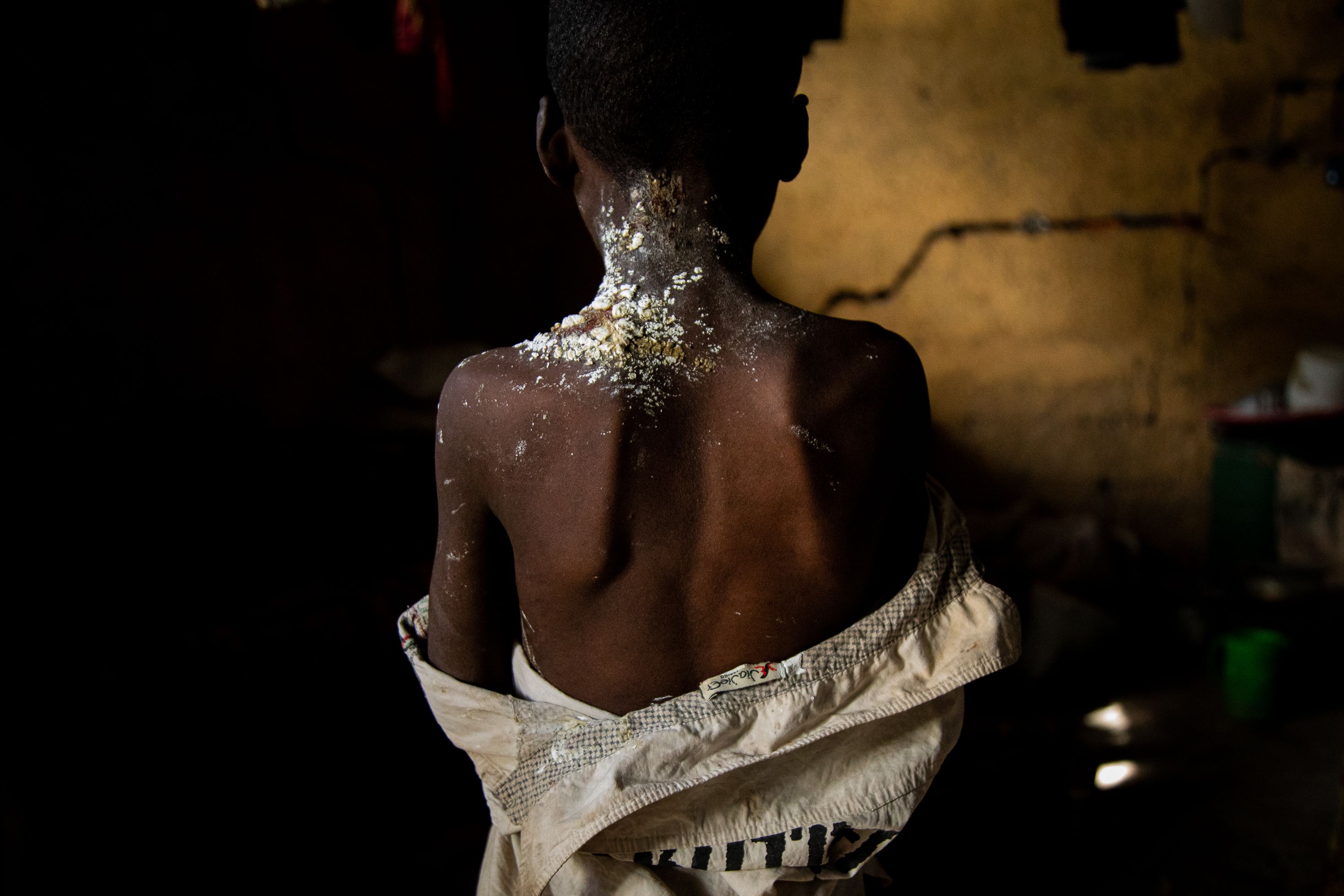-
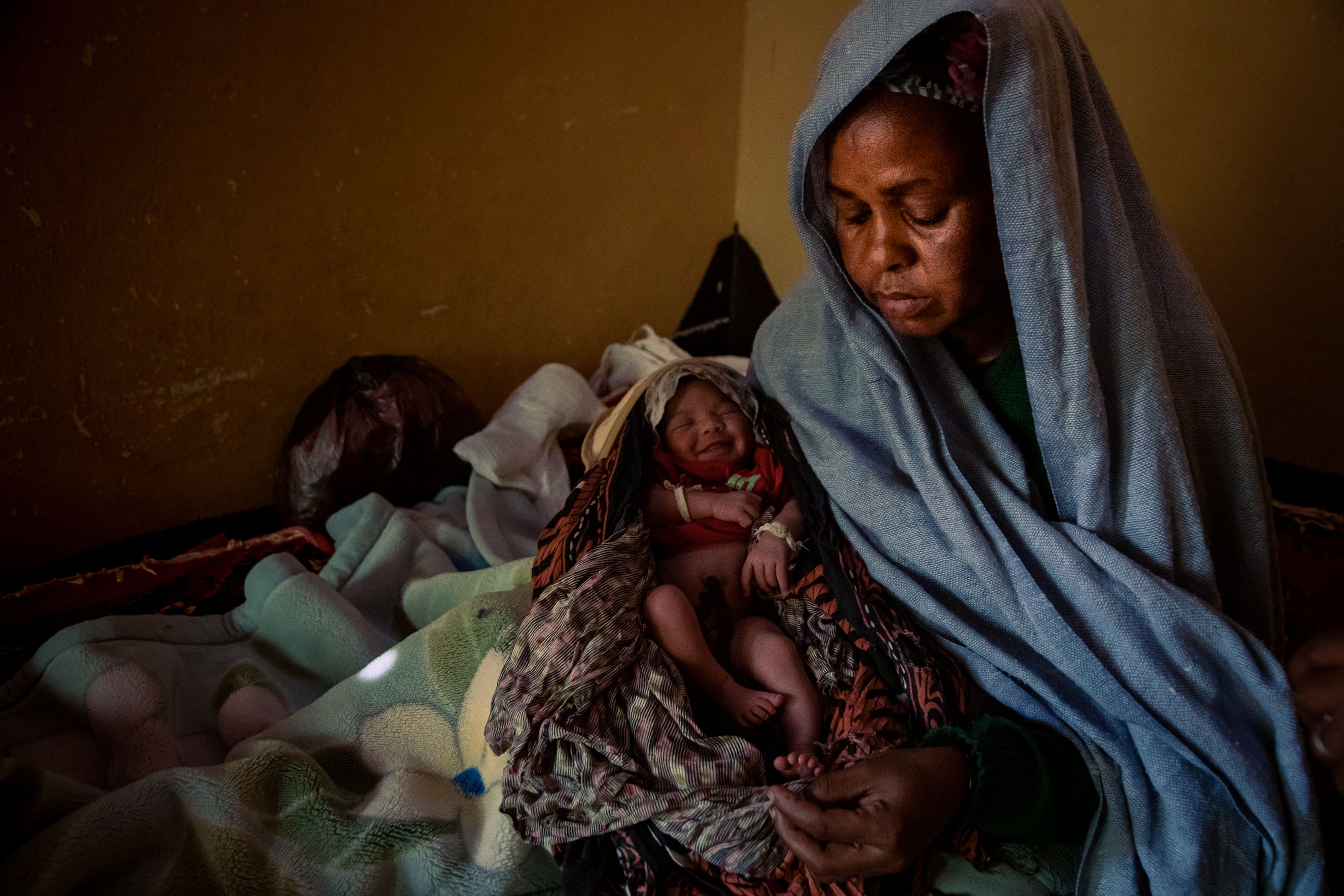
Rinsiti Kenase, 38, dresses her newborn child’s umbilical cord at her home in Fatsi, Tigray, Ethiopia. Kenase delivered her sixth child at home alone because the clinic closest to her house was occupied and looted by Eritrean forces and was thus incapable of offering maternal care services.
-
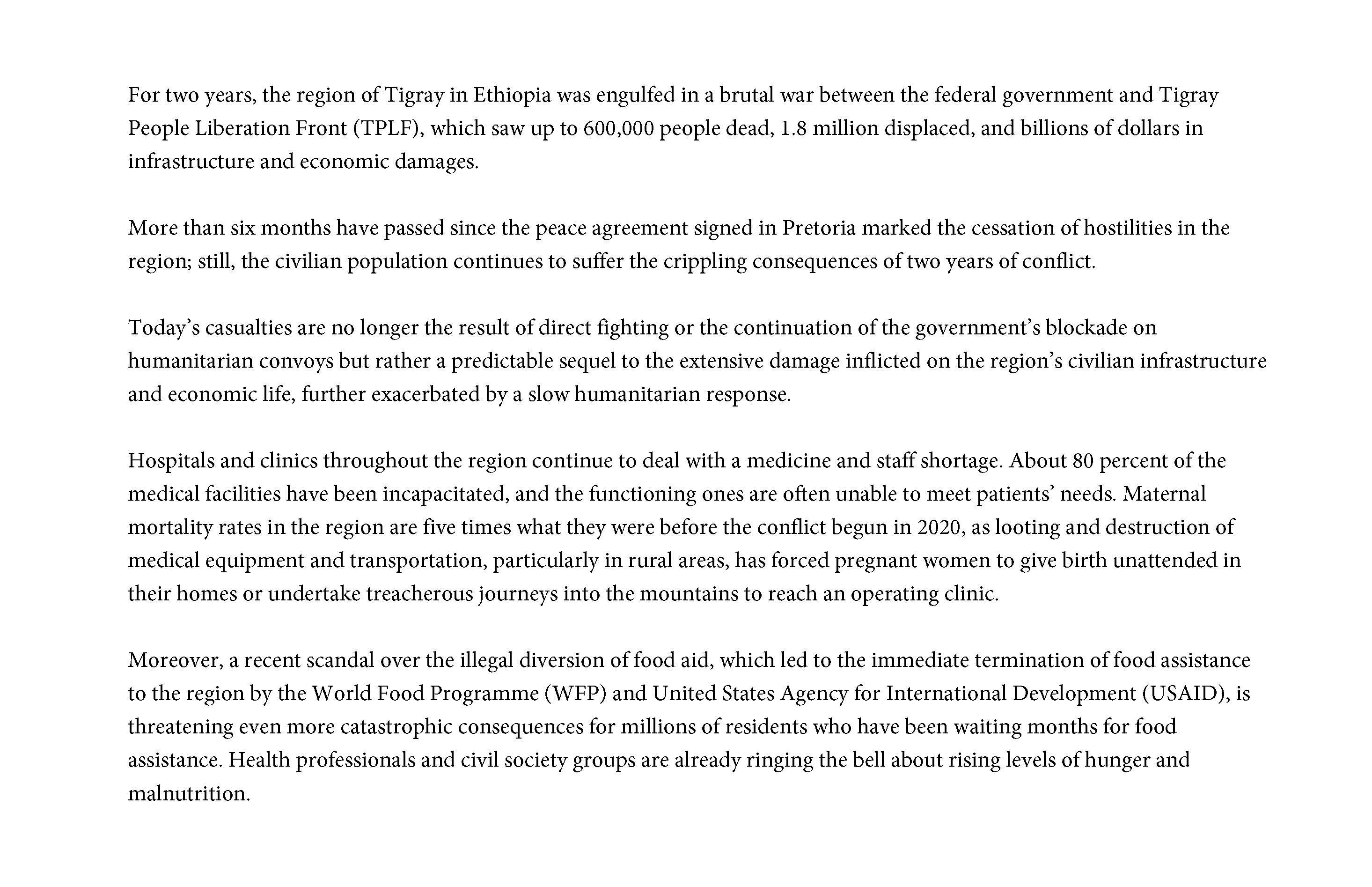
-
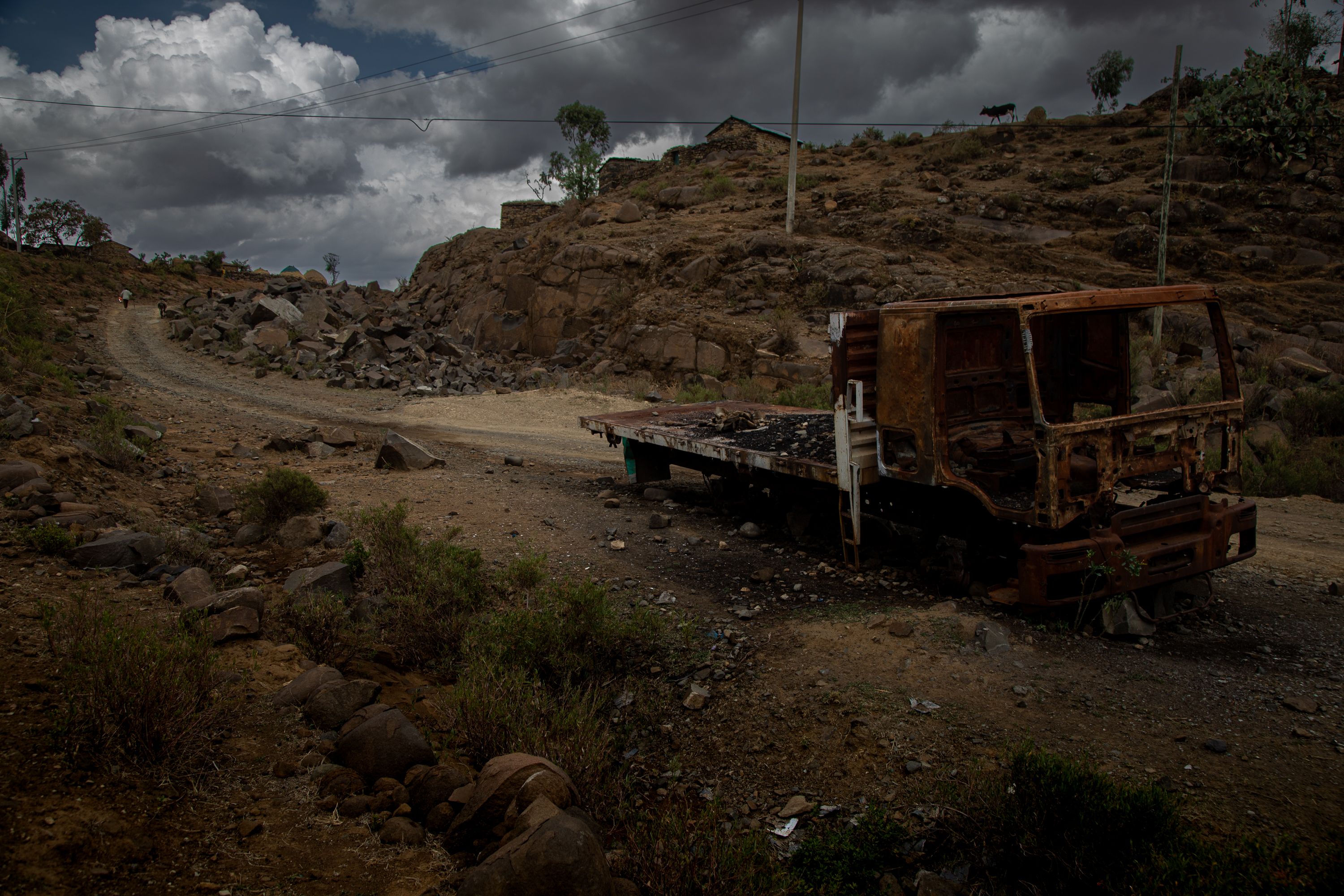
A destroyed truck belonging to the Eritrean army sits on the side of the road near Samre, Tigray, Ethiopia.
-
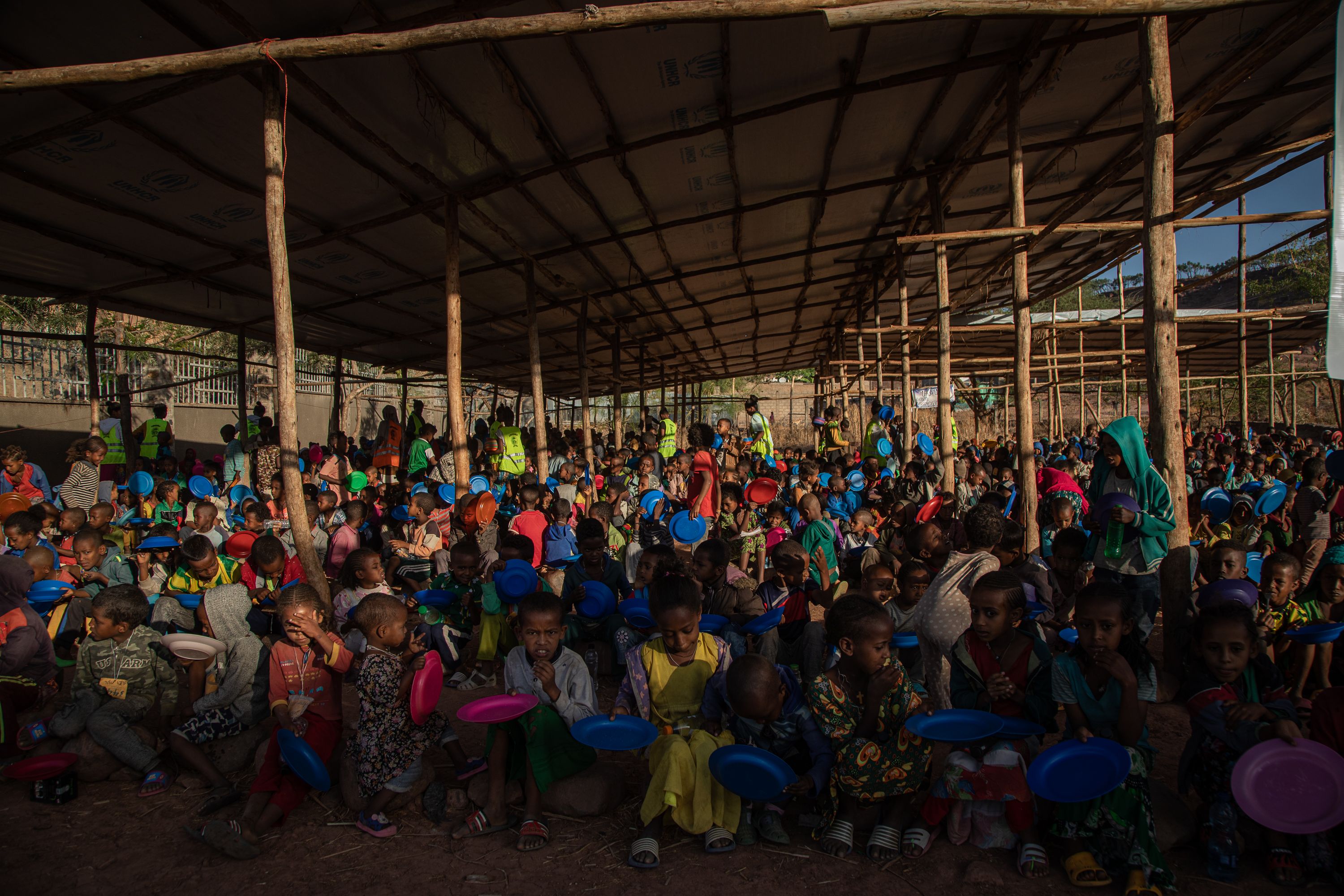
Children are served food by a group of volunteers at a repurposed library used for feeding up to 7,000 internally displaced children and pregnant women every morning in Abiy Addi, Tigray, Ethiopia. Humanitarian support has been slow to arrive in the region despite the cessation of hostilities and lifting of the government blockade, previously impeding aid organizations from accessing the area.
-
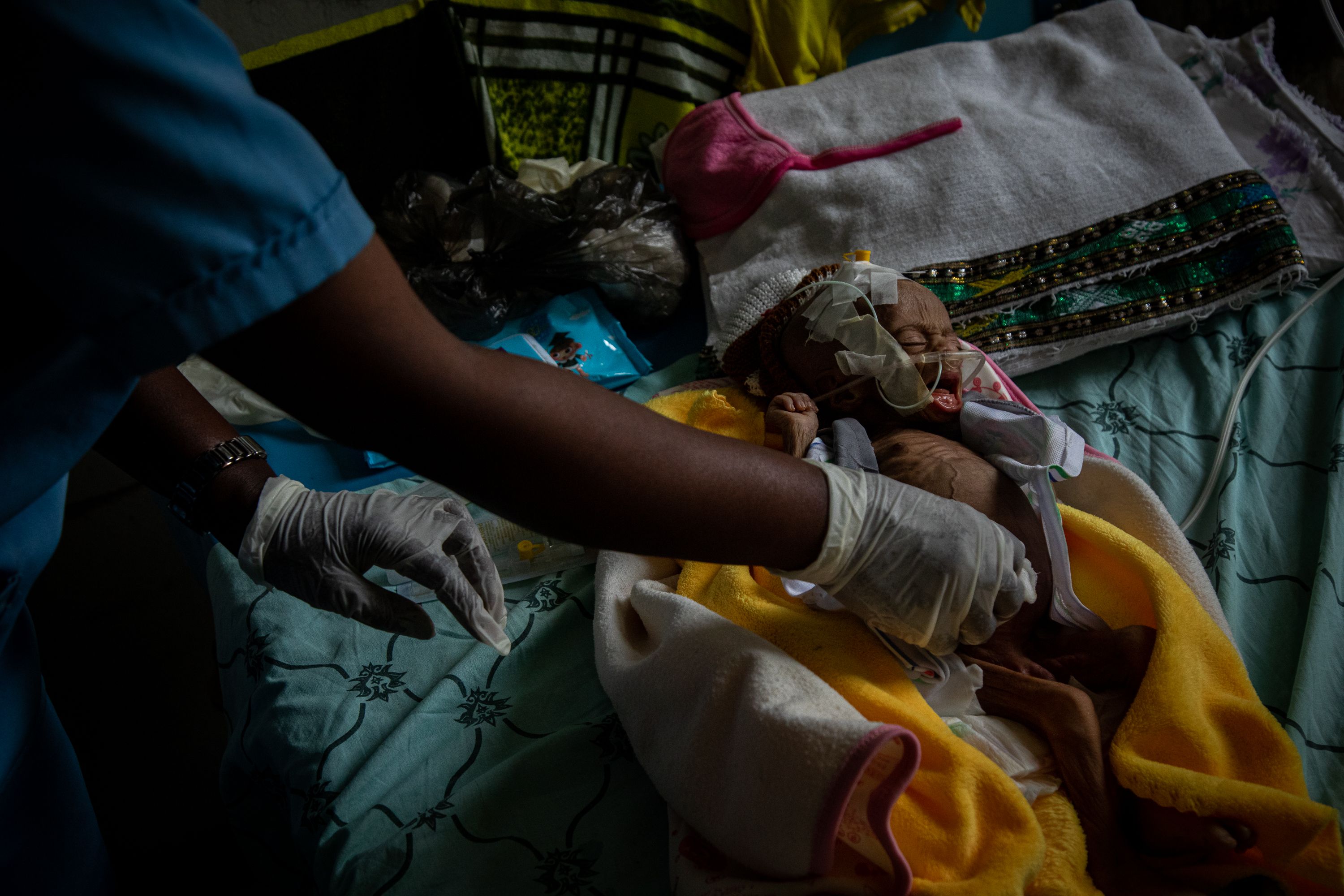
A child is treated for malnutrition at Ayder Referral Hospital in Mekele, Tigray, Ethiopia. Doctors are seeing an increase in child malnutrition cases despite the cessation of hostilities and the restarting of humanitarian assistance to the region. The US Agency for International Development (USAID) and the World Food Programme (WFP) have temporarily ceased food assistance, citing reports of diversion and illegal sales of aid in local markets.
-
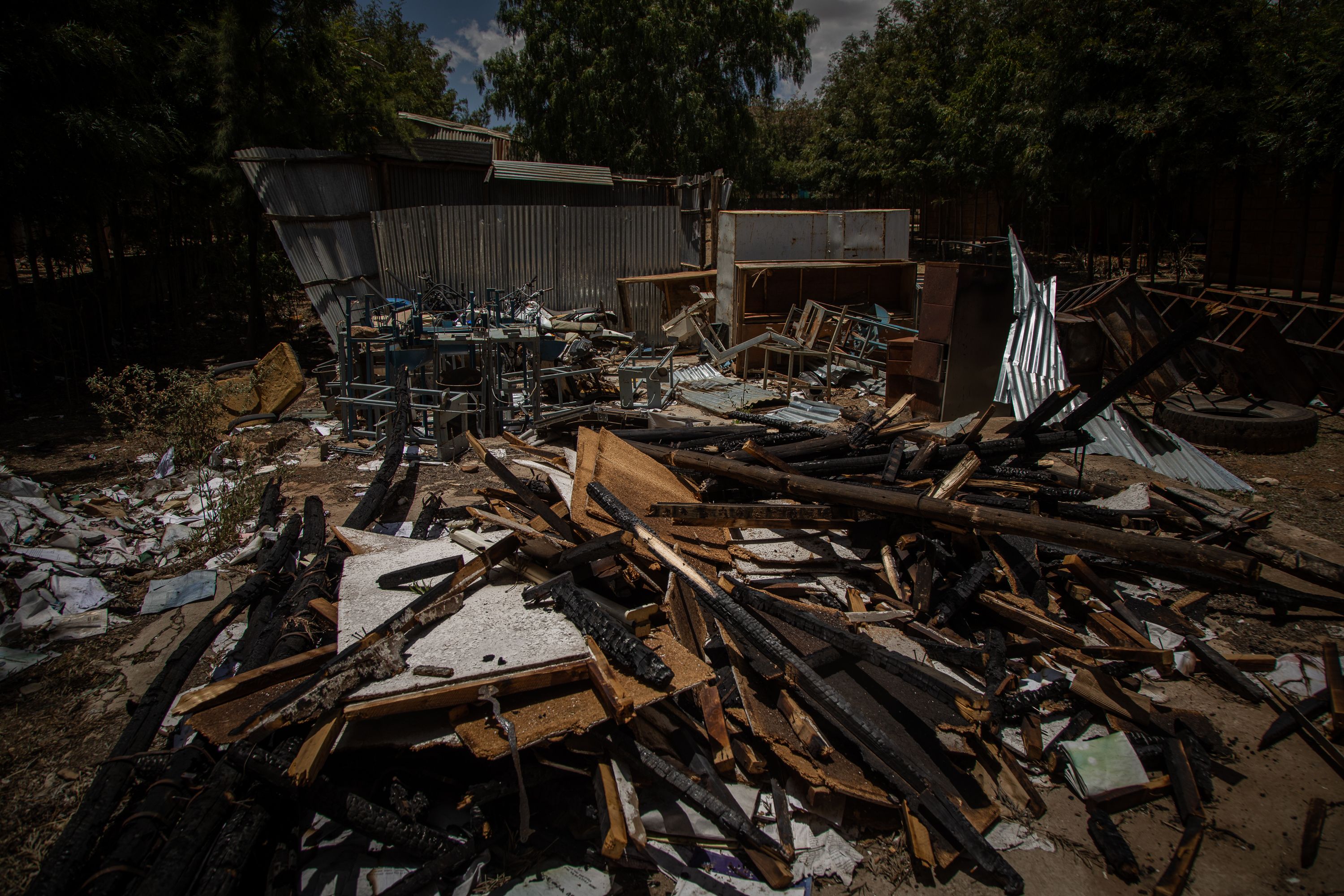
Damaged and burned furniture sits outside a clinic run by Save The Children in Fatsi, Eastern Tigray. The health facility incurred extensive damage and looting during the latest occupation by Eritrean forces from September 2022 to January 2023. According to Tigray Regional Health Bureau, approximately 80 percent of the health facilities have been incapacitated as a direct result of fighting.
-
![People line up to fill up water containers at a camp for internally displaced persons in Shire, Tigray, Ethiopia. Tigray'sPeacetimeCasualties_04002023-006.jpg]()
People line up to fill up water containers at a camp for internally displaced persons in Shire, Tigray, Ethiopia.
-
![Lychee Fasehaye with her two children at a camp for internally displaced persons in Shire, Tigray, Ethiopia. Fasehaye and her two children have been living in the overcrowded camp for the past two years since they were forced to flee from violence in Western Tigray. Tigray'sPeacetimeCasualties_04002023-007.jpg]()
Lychee Fasehaye with her two children at a camp for internally displaced persons in Shire, Tigray, Ethiopia. Fasehaye and her two children have been living in the overcrowded camp for the past two years since they were forced to flee from violence in Western Tigray.
-
![Burned medical records lay on the ground at a damaged clinic run by Save The Children in Fatsi, Eastern Tigray. The health facility incurred extensive damage and looting during the latest occupation by Eritrean forces from September 2022 to January 2023. According to Tigray Regional Health Bureau, approximately 80 percent of the health facilities have been incapacitated as a direct result of fighting. Tigray'sPeacetimeCasualties_04002023-008.jpg]()
Burned medical records lay on the ground at a damaged clinic run by Save The Children in Fatsi, Eastern Tigray. The health facility incurred extensive damage and looting during the latest occupation by Eritrean forces from September 2022 to January 2023. According to Tigray Regional Health Bureau, approximately 80 percent of the health facilities have been incapacitated as a direct result of fighting.
-
![A woman walks through the streets of Adrigrat, Tigray, six months into the cessation of hostilities marked by the signing of the Peace Agreement in Pretoria. Tigray'sPeacetimeCasualties_04002023-009.jpg]()
A woman walks through the streets of Adrigrat, Tigray, six months into the cessation of hostilities marked by the signing of the Peace Agreement in Pretoria.
-
![A waiting room at Ayder Referral Hospital in Mekele, Tigray, Ethiopia. The hospital has been overwhelmed with patients coming from across the region for routine and lifesaving treatments as 80 percent of the health facilities in Tigray have been incapacitated during the two-year conflict. Tigray'sPeacetimeCasualties_04002023-010.jpg]()
A waiting room at Ayder Referral Hospital in Mekele, Tigray, Ethiopia. The hospital has been overwhelmed with patients coming from across the region for routine and lifesaving treatments as 80 percent of the health facilities in Tigray have been incapacitated during the two-year conflict.
-
![Absey Teka (left), Gebrekidan Alemayoh (right), and their two children at a camp for internally displaced people where other 8,000 people live in Shire, Tigray, Ethiopia. Despite the need for frequent medical checkups, their youngest son, who is diagnosed with macrocephaly, has been unable to see a doctor for two years because of the conflict and the family’s lack of financial resources. Tigray'sPeacetimeCasualties_04002023-011.jpg]()
Absey Teka (left), Gebrekidan Alemayoh (right), and their two children at a camp for internally displaced people where other 8,000 people live in Shire, Tigray, Ethiopia. Despite the need for frequent medical checkups, their youngest son, who is diagnosed with macrocephaly, has been unable to see a doctor for two years because of the conflict and the family’s lack of financial resources.
-
![A view of the mountains near Fatsi, Eastern Tigray, Ethiopia. Tigray'sPeacetimeCasualties_04002023-012.jpg]()
A view of the mountains near Fatsi, Eastern Tigray, Ethiopia.
-
![Mothers gather with their children at a clinic run by Save The Children in Fatsi, Eastern Tigray, Ethiopia, for routine vaccinations. With NGOs' help, local health clinics are restarting routine vaccination programs that had been disrupted by the conflict. Childhood immunization levels in the region had dropped to 10 percent in the two years of fighting between the Ethiopian federal government and the TPLF from a previous high of 90 percent. The World Health Organization (WHO) documented a rise in disease outbreaks, including malaria, measles, acute respiratory infections, and other preventable diseases. Tigray'sPeacetimeCasualties_04002023-013.jpg]()
Mothers gather with their children at a clinic run by Save The Children in Fatsi, Eastern Tigray, Ethiopia, for routine vaccinations. With NGOs' help, local health clinics are restarting routine vaccination programs that had been disrupted by the conflict. Childhood immunization levels in the region had dropped to 10 percent in the two years of fighting between the Ethiopian federal government and the TPLF from a previous high of 90 percent. The World Health Organization (WHO) documented a rise in disease outbreaks, including malaria, measles, acute respiratory infections, and other preventable diseases.
-
![Kalayeta Abadi, 36, who’s undergoing labor, is carried on a traditional stretcher to the closest hospital in Samre, Tigray, Ethiopia. Lack of individual transportation and the destruction of ambulances during the conflict is forcing pregnant women to make hazardous journeys on foot to reach a health clinic during labor or deliver at home alone. Tigray'sPeacetimeCasualties_04002023-014.jpg]()
Kalayeta Abadi, 36, who’s undergoing labor, is carried on a traditional stretcher to the closest hospital in Samre, Tigray, Ethiopia. Lack of individual transportation and the destruction of ambulances during the conflict is forcing pregnant women to make hazardous journeys on foot to reach a health clinic during labor or deliver at home alone.
-
![Kalayeta Abadi, 36, who’s undergoing labor, is carried on a traditional stretcher to the closest hospital in Samre, Tigray, Ethiopia. Lack of individual transportation and the destruction of ambulances during the conflict is forcing pregnant women to make hazardous journeys on foot to reach a health clinic during labor or deliver at home alone. Tigray'sPeacetimeCasualties_04002023-015.jpg]()
Kalayeta Abadi, 36, who’s undergoing labor, is carried on a traditional stretcher to the closest hospital in Samre, Tigray, Ethiopia. Lack of individual transportation and the destruction of ambulances during the conflict is forcing pregnant women to make hazardous journeys on foot to reach a health clinic during labor or deliver at home alone.
-
![Kaleyta Abadi, 36, rests on a delivery bed after giving birth to her first child at Samre Health Center in Tigray, Ethiopia. Maternal mortality rates increased by five-fold compared to data recorded before the conflict began in 2020. The trend is attributed to the lack of accessible health clinics, medicines and medical staff capable of providing services during the conflict, particularly in more rural areas of the region. Tigray'sPeacetimeCasualties_04002023-016.jpg]()
Kaleyta Abadi, 36, rests on a delivery bed after giving birth to her first child at Samre Health Center in Tigray, Ethiopia. Maternal mortality rates increased by five-fold compared to data recorded before the conflict began in 2020. The trend is attributed to the lack of accessible health clinics, medicines and medical staff capable of providing services during the conflict, particularly in more rural areas of the region.
-
![A view of a room inside a damaged clinic run by Save the Children near Adwa, in Tigray, Ethiopia, that Eritrean forces used as a shelter during the latest round of occupation in the Eastern region of Tigray. Tigray'sPeacetimeCasualties_04002023-017.jpg]()
A view of a room inside a damaged clinic run by Save the Children near Adwa, in Tigray, Ethiopia, that Eritrean forces used as a shelter during the latest round of occupation in the Eastern region of Tigray.
-
![Mehari Gebremeskel, 8, turns his back to the camera to display a fungal disease on his neck likely caused by the unhygienic conditions in the camp for internally displaced where he lives along with other 7,000 people in Shire, Tigray, Ethiopia. According to the International Organization for Migration, 1.8 million people are currently displaced in Tigray. Tigray'sPeacetimeCasualties_04002023-018.jpg]()
Mehari Gebremeskel, 8, turns his back to the camera to display a fungal disease on his neck likely caused by the unhygienic conditions in the camp for internally displaced where he lives along with other 7,000 people in Shire, Tigray, Ethiopia. According to the International Organization for Migration, 1.8 million people are currently displaced in Tigray.
